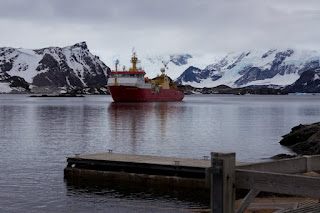There are only five of us at Signy this year. This is a bit unusual as we have eight beds available on station and often all of them are full. The number of people here depends on a couple of things- firstly, how many scientists have projects planned for the season, and then whether the ships travel itinery matches up with the scientists work plan and therefore whether the project is feasible. We do have two more scientists joining us in January bringing us up to seven on station.
Given the low numbers, a visit from a ship can suddenly seem a bit of a shock as the base transforms into a bustling hive of activity and people. The feelings are rather mixed. Part of you feels like your home is being invaded by tourists who wander through your living space, upsetting the fine balance of life that you have established with your fellow station members. The other part of you is quite excited, for they bring great enthusiasm and excitement, and sometimes new people or supplies.
Last week two ships visited. The first visit was from the Bark Europa.
The Bark Europa is a cruise ship with a difference. Unlike modern cruise ships, with all their luxuries, the Europa is a tall ship, over 100 years old, that had sailed all the way from Ushuaia, Argentina, using only the power of the wind. Originally a light ship, protecting a hazardous stretch of river in Germany, she was re-rigged as a Barque in the 1980's as a sail training ship. The tourists onboard all muck in together, working alongside the crew and trainee sailers on their exciting voyage.
After a tour of our station, they kindly repaid the favour, allowing us onboard for a tour of their ship and a cup of tea. There seemed to be an awful lot of ropes! Here is me, Doug and Iain onboard.
Both inside and out the Europa is beautiful. I suspect in a sea of icebergs, with all sails up, it must be quite a sight! Later they set sail, heading south towards the Antarctic Peninsula.
A couple of days later, one of our own ships, the Ernest Shackleton, came to visit. We awoke to find her parked almost on the doorstep!
The bay is too shallow for the Shackleton to reach the jetty, so they launched their small boats. The Shackleton was dropping of our new Scientist Jes and taking away our generator mechanic Doug, who has been here since the start of the season. It also brought us a new batch of fresh fruit and veg, and various bits of cargo. Onboard this time were a group of people bound for Halley research station, and they came ashore to help with cargo and have a look around. Again, we went onboard, this time for lunch and a chat with the captain and his crew.
Once the ships had gone, normality resumed and we settled back into work. The next ship we will see is the James Clark Ross (which we arrived on in November), around the end of January.







No comments:
Post a Comment